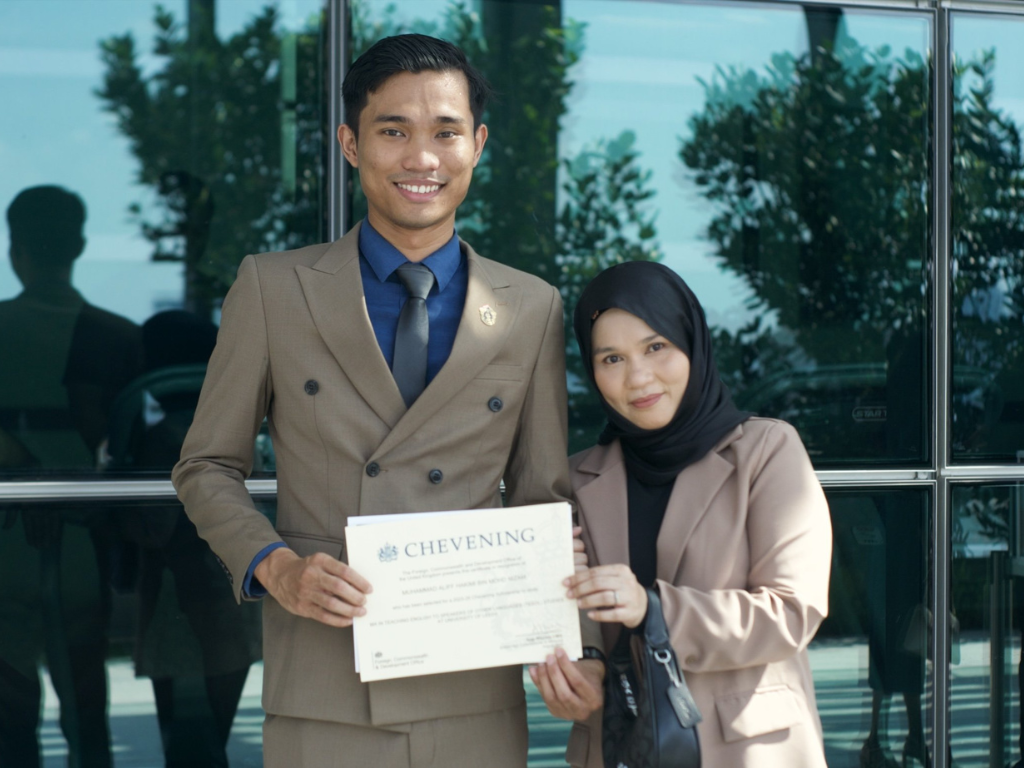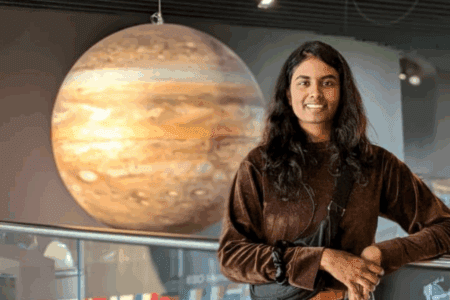
2% to 3% — that’s the success rate for the Chevening Scholarship.
In 2023-24, there were a total of 102,274 applications submitted, making it the highest in Chevening’s history. Only a total of 1,360 applicants were awarded and welcomed to the UK.
It’s undoubtedly one of the hardest scholarships to secure in the world, and it usually takes a couple of tries for one to successfully secure the scholarship.
For Muhammad Aliff Hakimi bin Mohd Nizam, it only took him one try. In fact, there were a lot of firsts for him.
“I got accepted on my first try, and I’m also the first in my family, bloodline, to study abroad,” shares the MA in TESOL student at the University of Leeds.
How did someone from a rural state in small country like Malaysia, who could barely speak English even at 17 years old, do it?
Well, Aliff had a plan — a pretty good one.

Aliff is one of the 34 Malaysian scholars who will be pursuing one-year master’s programmes across the UK for the 2025-26 academic year. Source: Muhammad Aliff Hakimi bin Mohd Nizam
Chevening Scholarship: Here’s everything Aliff wants you to know and do
Have a goal in mind
Aliff’s first advice is to know what you’re working towards.
“I applied to Chevening with a purpose,” he says. “And it’s to make Malaysia the leading educational hub in the region, as well as making the English language as inclusive as possible.”
Chevening scholars are required to return home for two years after completing their master’s programme.
For Aliff, coming home to make change happen was no doubt the one thing he wanted to achieve, and he even has a long-term plan to join Malaysia’s Ministry of Education to reform its English education system.
“I want to become a lecturer; however, if I were to implement change as one, it would only be to a classroom of 30 to 40 students,” Aliff shares. “I want to improve the country as a whole. That’s my vision.”
Having that goal set in mind will help the admissions committee to know your intentions and what you want to achieve in the next few years, giving you a higher chance of securing the internship.

Aliff completed his diploma and undergraduate studies in Malaysia before pursuing his master’s in the UK. Source: Muhammad Aliff Hakimi bin Mohd Nizam
Work experience is key
You’ll have to have at least 2,800 hours (approximately four months) of work experience after graduating from your undergraduate degree to be eligible for the scholarship.
“Before pursuing my diploma, I actually worked as a security guard at two hospitals,” Aliff shares. “It’s not a famous job among youths, but that helped me earn some money and experience to interact with patients and their families.”
Aliff held several English language teaching jobs throughout his undergraduate degree.
- English language teacher internship at the Ministry of Education, Malaysia
- English language teacher at SifuTutor
- Colorguard tutor at Universiti Kebangsaan Malaysia (A colorguard tutor designs routines fo marching bands)
- English as a Second Language (ESL) teacher at GL Education Group
- English language teacher cum marketing at Progressive Language Academy
In total, he has way more than 2,800 hours, and the majority of the jobs he has taken up are related to his undergraduate and master’s degrees.
Wanting to make an impact in society is key
A scholarship isn’t meant to be handed to you on a silver platter. You have to work on it — and it’s not through books.
“I learnt that getting the scholarship is not all about being booksmart, but how one serves a community,” Aliff shares.
In late 2024, Aliff founded “Edukasi Emosi,” an educational workshop to address emotional management challenges among primary school students at a local high school.

Thanks to the Chevening Scholarship, Aliff had the opportunity to visit London. Source: Muhammad Aliff Hakimi bin Mohd Nizam
Aliff recognises that children today are facing stress from academics, peer relationships, and home environments.
Through the workshop, he, alongside community members and a certified counsellor from Sunway Education Group, successfully equipped 34 student leaders with tools to manage their emotions and motivate their peers despite challenges.
“Founding this workshop was based on my own personal trauma, getting judged when speaking in English,” Aliff says.
So, if you’re planning on applying for the Chevening Scholarship, consider helping your local community, even in the smallest ways.
Highlight leadership experiences in your essays
If you didn’t already know, you’re required to respond to four essay questions as part of the application — leadership, relationship-building, your course choices, and future career goals.
“I really focused on my leadership experiences rather than my teaching experiences,” Aliff shares.
“I wrote about running my own initiatives, as well as a project that my two friends and I started — visiting a rural orphanage to teach English and supply food supplies. Then I moved on to talking about ‘Edukasi Emosi’ and ‘Global Talk,’ a programme where I connected with Malaysian student leaders in Australia to help us learn about how Australians lead compared to Malaysians.”

Aliff and his mum during the Chevening Scholarship award ceremony. Source: Muhammad Aliff Hakimi bin Mohd Nizam
Nail the interview
When Aliff walked into the room, he was greeted by three individuals, the British Chevening Officers from London and Malaysia.
It was a pleasant interview that lasted about 25 to 30 minutes with a lot of questions.
“Most of the questions were about me, then they segued into my essay. As nice as they were, I looked at it as a threat,” he says
“From a psychological point of view, I think it was a strategy they had in mind where they wanted to make me feel comfortable and let my guard down by being welcoming. That’s just my personal take on it.”
To prepare for the interview, he dedicated his commuting hours to practise his speech and how he would answer the questions. He’d even spend time in the shower thinking about what questions would be asked and how he’d answer them.
If you were to see Aliff’s wall, it would be filled with many sticky notes of possible ways he could answer questions.
“They don’t want general answers as they already know the answer; they want to hear about the bigger picture,” he shares.
Aliff did something different too — by taking control of the interview.
“At the end of the interview, I was allowed to ask two questions, which I did, and ended up asking them if I could summarise who I am as a person,” he says.
And he did, in less than 15 seconds, in just three sentences.
“It went along the lines of I’m someone who comes from a rural area and often gets bad judgments with how I speak English,” Aliff shares. “I have a purpose and vision to make Malaysia a leading educational hub, as well as to make English inclusive. The Chevening Scholarship will allow me to do that, not only through a master’s degree, but getting to know the right people at the right institute.”
If you were to add that to your list of must-dos, you may secure the Chevening Scholarship on your first try.










